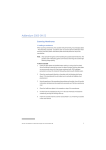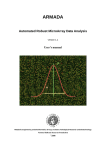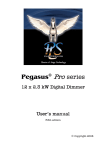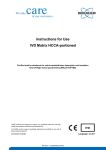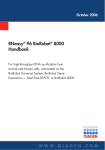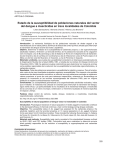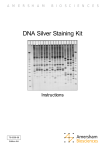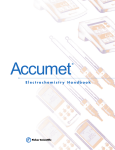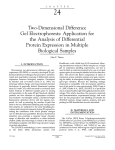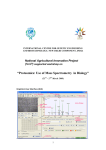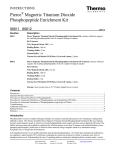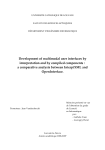Download Proteomics in ADME/Tox studies: Automated spot handling of
Transcript
DIGE approved application note Automated spot handling Proteomics in ADME/Tox studies: Automated spot handling of peptides prior to MALDI and electrospray MS identification of proteins altered by drug treatment S key words: Ettan Spot Handling Workstation • protein identification • Ettan DIGE system • sample preparation • MALDI-ToF MS • LC-MS/MS This application describes the use of the Ettan™ proteomics platform to produce biologically significant proteomics data. Samples from livers of mice either treated with a candidate drug or untreated were quantified, labeled, and subjected to 2-D gel electrophoresis. Following 2-D gel scanning and imaging, pick lists that included protein spots differentially regulated following treatment with the candidate drug were created for unattended, reproducible spot handling on Ettan Spot Handling Workstation. Subsequent mass spectrometry using MALDI-ToF, chemically assisted fragmentationMALDI, and LC-MS/MS resulted in confident identification of 100% of the proteins showing at least 50% changed level after treatment with the drug candidate. Pooled standard sample Sample treated with candidate drug Label with CyDye DIGE Fluor Cy5 minimal dye* Label with CyDye DIGE Fluor Cy2 minimal dye Untreated sample Label with CyDye DIGE Fluor Cy3 minimal dye* mix 2-D gel electrophoresis Imaging, matching pick list Ettan Spot Handling Workstation Introduction It is estimated that about 50% of drugs in development fail during clinical trials because of deficiencies in their ADME/ Tox (absorption, distribution, metabolism, elimination, and toxicity) properties (1). The cost of these failures so late in the drug development process is naturally very high. In addition, it has been suggested that over 5% of hospitalized patients still suffer serious adverse reactions to drugs that have successfully completed their development and come onto the market (1). Improved means of gathering ADME/ Tox information earlier in drug development should thus benefit pharmaceutical manufacturers and, of course, patients. We have investigated whether a proteomics approach would identify differential levels of mouse liver proteins after treatment of mice with a candidate drug. Such information could help elucidate which proteins are involved in metabolism and toxicity and thus increase the value of ADME/Tox studies in drug discovery. an 11-0004-19 AA, 2004-03 • p1 Spotting Digestion Spot picking LC-MS/MS mically assisted mentation-MALDI MALDI-ToF PMF Fig 1. The experimental workflow used for the successful (100%) identification of proteins selected by the criterion of displaying at least a 50% change in abundance after treatment with the candidate drug. * In the experimental workflow, a second gel was run where the labelling was reversed i.e. treated sample was labeled with Cy3 and the untreated sample labeled with Cy5 CyDye DIGE Fluor minimal dye respectively. Automated spot handling The Ettan design platform offers a complete solution of reagents, kits, and systems for proteomics-based research at a stage before biological validation is feasible. Central to the whole proteomics workflow is the Ettan Spot Handling Workstation, a highly flexible and robust system that allows fully-automated, unattended low- and/or high-throughput handling of protein spots separated by 2-D gel electrophoresis. A key feature of the workstation is that it avoids the manual errors that normally have a negative impact on obtaining reproducible results. Avoiding such errors is of critical importance since downstream biological validation of the data obtained is very labor intensive. Every effort made to gather reproducible and accurate data at the proteomics experimental stage will pay dividends later. In other words, it is essential that the “right” spots are chosen and picked for downstream validation studies. Figure 1 illustrates the full experimental workflow and key techniques used in the investigation, which are described in more detail in the Methods section. Products used Amersham Biosciences products used: Ettan sample preparation kits and reagents 2-D Clean-Up Kit 2-D Quant Kit DeStreak Reagent 80-6484-51 80-6483-56 17-6003-19 2-D electrophoresis systems and consumables CyDye DIGE Fluor Cy2 minimal dye, 25 nmol CyDye DIGE Fluor Cy3 minimal dye, 25 nmol CyDye DIGE Fluor Cy5 minimal dye, 25 nmol Immobiline DryStrip, pH 3–10 NL 24 cm Ettan IPGphor II IEF System Ettan DALTtwelve Large Vertical Electrophoresis System Typhoon 9410 Variable Mode Imager DeCyder Differential Analysis Software RPK0272 RPK0273 RPK0275 17-6003-77 80-6505-03 80-6466-27 60-0055-81 18-1163-05 Spot handling and mass spectrometry Ettan Chemicals Trypsin, Sequencing Grade Ettan Chemicals Trifluoroacetic Acid, Ettan Spot Handling Workstation Ettan MALDI-ToF Pro Ettan CAF MALDI Sequencing Kit an 11-0004-19 AA, 2004-03 • p2 17-6002-75 17-6002-76 18-1164-05 18-1156-53 17-6002-97 Other materials required SYPRO Ruby stain (Molecular Probes) Alpha-cyano-4-hydroxycinnamic acid (LaserBio Labs) Biobasic C18 column (Thermo Hypersil) Finnigan ProteomeX Workstation (Thermo Electron Corporation) Finnigan LTQ Linear Ion Trap Mass Spectrometer (Thermo Electron Corporation) Finnigan LCQ Deca XP Plus Ion Trap Mass Spectrometer (Thermo Electron Corporation) Methods Treatment of mice with candidate drug The selected candidate drug was administered orally to inbred C57BL/6 mice over five days. Livers from treated mice and untreated littermates were removed, dissected, and snap frozen in liquid nitrogen. Sample preparation and quantitation Sample (0.5 g) of each liver (three treated livers and one pooled control each of three untreated livers) were rinsed in PBS and homogenized in 10 volumes (5 ml) lysis buffer (10 mM Tris-HCl pH 8.3, 7 M urea, 2 M thiourea, 5 mM magnesium acetate, 4% CHAPS) according to reference 2. To remove interfering nonprotein material, 2-D Clean-Up Kit was used on a 10 × 100 µl homogenate according to the kit instructions. 2-D Quant Kit was used to quantitate the prepared samples, also according to the kit instructions. Sample labeling Samples were thawed and their pH determined by pipetting 1 µl of each onto pH paper. The pH was adjusted to between pH 8.0 and pH 8.5 by adding 2 µl of 50 mM NaOH to each 100 µl aliquot of homogenate. One-hundred microgram of each sample was labeled according to reference 3. Individual samples (treated and untreated livers) to be analyzed were labeled with CyDye™ DIGE Fluor Cy™5 minimal dye and CyDye DIGE Fluor Cy3 minimal dye respectively. In addition, a pooled standard containing all samples included in the experiment was prepared and labeled with CyDye DIGE Fluor Cy2 minimal dye. The differently labeled individual samples and the pooled standard were mixed prior to 2-D electrophoresis. 2-D gel electrophoresis First dimension: Cup loading was selected for analytical electrophoresis. One-hundred and fifty microgram of the mixed sample (50 µg of each Cy2, Cy3, and Cy5-labeled sample on each gel) was applied to each 24-cm Immobiline DryStrip, pH 3–10 NL. For preparative electrophoresis, 1 mg samples were loaded onto 24-cm Immobiline™ Automated spot handling DryStrip gels, pH 3–10 NL by in-gel rehydration in DeStreak™ Rehydration solution + 2% IPG buffer, pH 3–10. The rehydration step was performed according to the user manual. Second dimension: Electrophoresis (2 W/gel) was performed overnight using lab-cast gels (4) on Ettan DALTtwelve electrophoresis system according to the protocols in reference 5. The preparative gels were poststained by SYPRO™ Ruby according to the manufacturer’s instructions. Scanning Each gel was scanned at 100 µm resolution on Typhoon™ 9410 Variable Mode Imager using 520BP40 (Cy2), 580BP30 (Cy3), and 670BP30 (Cy5) emission filters. Image analysis Images were analyzed using DeCyder Differential Analysis Software, v5.0 in both the DIA and the BVA modules. For statistical analysis, two-way ANOVA was used with the Student’s t-test value set to 0.01 ± 1.5 times intensity. Individual images were created for the different Cy2, Cy3, and Cy5 labeled gels and matched using DeCyder software. Two preparative gels were added to the experimental study and parallel pick lists that included all spots of interest (i.e. those differentially regulated following treatment with the candidate drug) were created for subsequent spot handling prior to mass spectrometry. Automated spot handling Selected proteins were subjected to fully automated spot handling in Ettan Spot Handling Workstation. A method that included spot picking, digestion, and spotting on Ettan MALDI target slides was selected in the software, and the whole procedure was run automatically overnight without any manual intervention either within or between steps. In this automated procedure, gel plugs were cut by a 2-mm picking head and washed twice in 50% methanol and 50 mM ammonium bicarbonate and once in 75% acetonitrile before drying. For digestion, 10 µl trypsin solution (0.2 µg Trypsin, Sequencing Grade, [Ettan Chemicals]) was added before incubation at 37 °C for 2 h. Extraction was performed in two steps by addition of 50% acetonitrile and 0.1% Trifluoroacetic Acid (Ettan Chemicals). The pooled extract was finally dried prior the two-step spotting procedure, where the matrix solution of 5 mg/ml solution of recrystallized α-cyano-4-hydroxycinnamic acid (LaserBio Labs) in extraction liquid was deposited on the target. In the final step before MALDI-ToF, a tenth of the dissolved sample was mixed with the matrix an 11-0004-19 AA, 2004-03 • p3 layer on the target, leaving the rest for other analyses, e.g. chemically assisted fragmentation-MALDI and LC-MS/MS. Protein identification using MALDI-ToF, chemically assisted fragmentation-MALDI, and LC-MS/MS Protein identification by peptide-mass fingerprinting (PMF) was performed on Ettan MALDI-ToF Pro. Data acquisition, spectrum processing, and database searches were performed in automatic mode with internal calibration using trypsin. To further improve the identification rate, chemicallyassisted fragmentation-MALDI was used on proteins not successfully identified by PMF. This technique enables peptide sequence data to be acquired simply, quickly, and with good sensitivity by analyzing the CAF-labeled peptides in post-source decay (PSD) mode on Ettan MALDI-ToF Pro. Finally, the few spots that were still not identified using MALDI MS were subjected to LC-MS/MS analysis. The tandem mass spectrometric analysis was performed on Finnigan™ LTQ™ linear ion trap mass spectrometer (Thermo Electron Corporation) fitted with Biobasic C18 column (100 × 0.1 mm, Thermo Electron Corporation) running at 1 µl/min flow rate. A fast gradient profile enabled a total analysis time of 20 min during which approximately 5500 scans were acquired using the data-dependent “triple play routine”. In this mode, peptides detected in a survey scan are selected for high-resolution Zoom Scan followed by fragmentation by MS/MS. The spectra were then processed automatically by SEQUEST™ to get unambiguous identification based on peptide sequence contained in the product ion spectrum. The built-in features of data dependent acquisition™ and dynamic exclusion™ allows automated collection of useful data and enables efficient handling of coeluting peptides, ensuring maximum sensitivity and sequence coverage for identified proteins. Results and discussion As expected when preparing samples from an organ like the liver, the protein concentration in the four lots was about 10 mg/ml (treated 1, 10.02 mg/ml; treated 2, 9.67 mg/ml; treated 3, 10.23 mg/ml; pooled untreated control, 10.40 mg/ml), i.e. 1/100 of the prepared sample was protein. This points to a very high recovery since about 1/10 of organs should consist of protein and the 0.5 g samples were diluted 10 times in 5 ml lysis buffer. After 2-D gel electrophoresis and image analysis, DeCyder software fully matched 1450 spots between the three different images for each gel. Figure 2 shows the matched spots. Automated spot handling Number of protein spots matched on the 2-D gel 1450 Protein spots processed through Ettan Spot Handling Workstation 552 Proteins identified i automatic mode 298/552 Proteins found to be at least 50% up- or down-regulated 30/552 Proteins identified by peptide mass fingerprinting Fig 2. Protein spots (1450) matched on the 2-D gel by DeCyder Differential Analysis Software. A picklist of 552 spots was generated and automatically transferred to Ettan Spot Handling Workstation. 24/30 Proteins identified by chemically assisted fragmentation 4/6 Proteins identif ed by LC-MS/MS Of these 1450 protein spots, 30 spots were found to be differentially regulated. A total of 552 spots, including the 30 diferentially regulated spots, were selected as a reasonable test for automatic spot handling on the workstation (which can handle a maximum of 1152 samples from up to twelve gels per batch). The picklist was thus generated and automatically transferred to Ettan Spot Handling Workstation, which used it to pick, digest, and spot all 552 proteins, again with full automation and no manual intervention. All 552 spotted proteins gave PMF spectra following preparation in Ettan Spot Handling Workstation. When expectation values <0.05 were collected, 298 of these spots (54%) were automatically identified. Manual editing should increase this number significantly. Figure 3 illustrates the results workflow and shows the methods and outcome of the protein identification. 2/2 (5/5) Fig 3. Workflow from the initial matching of 1450 spots on the 2-D gels to the successful identification of all 30 mouse liver proteins up- or down-regulated by more than 50% following treatment with a candidate drug (LC-MS/MS was used to confirm three identities made by the other two methods). At this stage, we decided to focus on identifying the regulated 30 proteins. MALDI-ToF analyses identified 24 of the 30 regulated proteins (80%) directly by peptide-mass fingerprinting. Figure 4 shows the spectrum of one of these 24 proteins, later identified as formyl transferase (position 8 in Table 1). Six spots were analyzed by chemically assisted fragmentation-MALDI of which four (67%) were successfully identified (spectra not shown). For the two remaining proteins, an LC-MS/MS method using the Finnigan ProteomeX™ Workstation and LCQ™ Deca XP Plus Ion Trap Mass Spectrometer proved successful (example shown in Fig 5). The LC-MS/MS approach was also used to confirm three identifications made by MALDIToF and chemically assisted fragmentation-MALDI. Table 1 shows the identities of all 30 proteins up- or down-regulated by more than 50% following treatment with the candidate drug. Picking accuracy was high. The backing of the gels stabilizes their dimensions and a self-adhesive label attached prior to scanning links the electronic image with the actual gel. In addition, the design and movement of the picked head ensured a clean and precise cut that also promotes high an 11-0004-19 AA, 2004-03 • p4 Automated spot handling picking efficiency. The clean cut, combined with hydrophobic coatings on the picking head and needles, minimized crosscontamination. Carry-over was not detected. Fig 4. Spectrum of a protein analyzed by MALDI-ToF following automated handling and preparation on Ettan Spot Handling Workstation. The protein was identified as formyl transferase (see Table 1, row 8). Fig 5. Product ion spectrum of peptide AFSVFLFNTENK (isopentenyldiphosphate delta-isomerase from mouse liver, abbreviated to IPP isomerase in Table 1 on rows 27 and 28) with highlighted b- and y-ion series fragments detected in the spectrum. Table 1. Protein identification results listing ID method, protein name, ID number (NCBI database), and relevant biochemical information. The protein whose spectrum is shown in Figure 4 is found at position 8 in this list. Average ratio shows extent of regulation, negative values indicate down regulation, positive values indicate up regulation. 1 2 3 4 5 6 7 8 9 10 11 12 13 14 15 16 17 18 19 20 21 22 23 24 25 26 27 28 29 30 ID me thod Average Ratio PMF PMF PMF PMF PMF M S/MS PMF PMF PMF P MF/MSMS CAF + PMF PMF PMF PMF PMF PMF PMF PMF PMF CAF CAF PMF PMF M S/MS PMF PMF PMF/M S/MS CA F/M S/MS PMF PMF -1.59 2.85 2.65 1.55 1.74 -1.54 -1.69 1.81 -1.61 2.75 -1.84 -1.68 1.90 1.56 -2.25 1.59 1.66 1.61 2.02 2.06 1.87 1.68 1.64 2.59 -2.22 -2.02 -1.75 2.21 -1.58 -1.54 Name Protein ID NCBI nr db carba moyl -phosphate synthetase 1 carba moyl -phosphate synthetase 1 carba moyl -phosphate synthetase 1 pyruvate carboxyl ase pyruvate carboxyl ase ornithine transcarbamyl ase sim il ar to elongation factor 2 Form yl transferase Form yl transferase ubiqui li n 1/serine protei nase i nhibitor esterase 31 + carboxylesterase 2 Liver ca rboxylesterase pre cursor T-complex protei n 1 3-hydroxy-3-m ethylgl utaryl-Coenzyme A synthase 1 sel enium binding protei n 2 3-hydroxy-3-m ethylgl utaryl-Coenzyme A synthase 2 3-hydroxy-3-m ethylgl utaryl-Coenzyme A synthase 2 methi onine adenosyl transferase I methi onine adenosyl transferase I 3-hydroxy-3-methyl glutaryl-Coenzyme A synthase 2 gamm a-actin cathepsin D farnesyl diphospha te synthetase hepatoma deri ved growth factor nudix thi oethe r S-methyltransferase thioether S-m ethyl transferase/IPP isom erase 1 peroxiredoxi n 4/IPP isom erase 1 Maj or urina ry protei ns 11 and 8 Maj or urina ry protei ns 11 and 8 8393186 23621369 8393186 7438124 7438124 762985 26328763 25050159 25050159 20072434/ 15079234 20886287/ 19527178 2494382 22654291 20988709 9507079 12836439 20965433 19526790 19526790 12836371 20885782 26354406 19882207 31560691 12847124 6678281 6678281/ 13878548 7948999/ 13878548 127531 127531 * Value above p = 0.01. The identity was, however, confirmed by CAF labeling and MS/MS respectively. an 11-0004-19 AA, 2004-03 • p5 Student's t-test (p =) 3.70 × 10-7 9.00 × 10-8 1.30 × 10-8 1.10 × 10-8 1.40 × 10-6 9.50 × 10-8 1.20 × 10-5 9.40 × 10-6 2.50 × 10-10 0. 0073 6.90 × 10-10 3.10 × 10-8 3.40 × 10-6 4.70 × 10-5 3.40 × 10-10 0. 0025 5.30 × 10-6 1.70 × 10-6 8.10 × 10-10 2.80 × 10-6 0.064* 3.80 × 10-6 3.00 × 10-6 0.1* 9.80 × 10-9 1.60 × 10-10 2.40 × 10-8 7.00 × 10-9 5.40 × 10-7 0. 0022 pI theoreti cal Mol. weight 6.33 6.03 6.19 6.34 6.34 7.25 6.31 5.64 5.64 4.73 5.86 5.88 5.97 5.65 5.78 8.65 8.65 5.51 5.51 7.56 5.14 6.85 5.48 4.52 5.97 6 5.82 6.34 4.85 4.85 164580 116816 116273 129777 129777 108595 95257 99064 99064 74813 72638 60406 57477 57569 52628 56823 56823 43509 43509 56221 50041 48374 40582 40202 24603 29460 23239 22078 17560 17560 Automated spot handling Conclusions We have investigated the suitability of a highly automated proteomics approach to identify differential expression levels of proteins indicated in ADME/Tox processes. Such information should lead to the discovery of useable biomarkers signaling drug toxicity, which would exclude the candidate drug from further development. This study showed the value of combining products from the Ettan range for sample preparation, differential gel electrophoresis by 2-D DIGE, automatic spot handling, and finally the identification of proteins by a combination of MALDI-ToF PMF, MALDI-ToF PSD of CAF-labeled peptides, and LC-MS/MS. Ettan Spot Handling Workstation played a central role in the overall investigation. The picklist generated by DeCyder Differential Analysis Software allowed automatic processing of all selected protein spots and made them ready for analysis by MS techniques. All proteins regulated following treatment with the candidate drug were thus successfully detected, selected, prepared, and identified in a smooth, accurate, and highly efficient manner. xenobiotic metabolism of drugs, as well as proteins that might be of importance in toxicity. Further work using narrower and more basic IPG strips to resolve more proteins on 2-D gels is under way. In addition, a focused study on proteins obtained by subcellular fractionation could prove to be very fruitful for further identification of proteins involved in metabolism and toxicity in the liver following administration of drugs. Greater understanding of these processes might significantly improve ADME/Tox investigations during drug discovery campaigns. References 1. Hodgson, J. ADMET – turning chemicals into drugs. Nature Biotechnology 19, 722–726 (2001). 2. Ettan DIGE User Manual, Amersham Biosciences 18-1164-40, edition AA, rat liver protocol p. 299 (2001). 3. Ettan DIGE User Manual, Amersham Biosciences 18-1164-40, edition AA, p. 39–40 (2001). 4. Ettan DIGE User Manual, Amersham Biosciences 18-1164-40, edition AA, p. 94 (2001). 5. Ettan DIGE User Manual, Amersham Biosciences 18-1164-40, edition AA, p. 59–64 (2001). The identified proteins were grouped in different functional categories and included proteins that may be involved in the to order: CAF, Cy, CyDye, DeCyder, DeStreak, Ettan, Immobiline, and Typhoon are trademarks of Amersham Biosciences Limited. Amersham and Amersham Biosciences are trademarks of Amersham plc. 2-D Fluorescence Difference Gel Electrophoresis (2-D DIGE) technology is covered by US patent numbers US6,043,025 and US6,127,134 and foreign equivalents and exclusively licensed to Amersham Biosciences. CyDye: This product or portions thereof is manufactured under licence from Carnegie Mellon University under patent number 5268486 and other patents pending. Some of these products may only be available to collaborators and customers within certain of our technology access programmes. The purchase of CyDye Fluors includes a limited license to use the CyDye Fluors for internal research and development, but not for any commercial purposes. A license to use CyDye Fluors for commercial purposes is subject to a separate license agreement with Amersham Biosciences. Finnigan, LCQ, LTQ, ProteomeX, SEQUEST, data dependent acquistion, and dynamic exclusion are trademarks of the Thermo Electron Corporation. SYPRO is a trademark of Molecular Probes Inc. Patent information: Chemically Assisted Fragmentation (CAF) is protected by patent application WO 00/ 43792 with foreign equivalents, as licensed from the Procter & Gamble Company to Amersham Biosciences AB, as well as WO 02/095412 and WO 02/095419, both co-owned by the Procter & Gamble Company and Amersham Biosciences AB. The purchase of Ettan CAF MALDI Sequencing Kit includes a limited license to use the technology for research internal research and development, but not for any commercial purposes. No right to perform or offer commercial services or products of any kind using the Sequencing Kit is hereby granted. A license to use the technology for commercial purposes is subject to a separate license agreement with Amersham Biosciences AB. Amersham Biosciences AB Björkgatan 30, SE-751 84 Uppsala, Sweden. Amersham Biosciences UK limited Amersham Place, Little Chalfont, Buckinghamshire HP7 9NA, England. Amersham Biosciences Corporation 800 Centennial Avenue, PO Box 1327, Piscataway, NJ 08855 USA. Amersham Biosciences Europe GmbH Munzinger Strasse 9, D-79111 Freiburg, Germany. Amersham Biosciences KK Sanken Building, 3-25-1, Hyakunincho, Shinjuku-ku, Tokyo 169-0073, Japan. All goods and services are sold subject to the terms and conditions of sale of the company within the Amersham Biosciences group that supplies them. A copy of these terms and conditions is available on request. © Amersham Biosciences AB 2004 – All rights reserved. an 11-0004-19 AA, 2004-03 • p6 Produced by Wikströms, Sweden 1040029, 03.2004 Printed matter. Licence 341 051 Asia Pacific Tel: +852 2811 8693 Fax: +852 2811 5251 Australia Tel: +61 2 9899 0999 Fax: +61 2 9899 7511 Austria Tel: 01 57 606 16 19 Fax 01 57 606 16 27 Belgium Tel: 0800 73 888 Fax: 03 272 1637 Canada Tel: 1 800 463 5800 Fax: 1 800 567 1008 Central, East, South East Europe Tel: +43 1 982 3826 Fax: +43 1 985 8327 Denmark Tel: 45 16 2400 Fax: 45 16 2424 Finland & Baltics Tel: +358 (0)9 512 3940 Fax: +358-(0)9-512 39439 France Tel: 0169 35 67 00 Fax: 0169 41 9677 Germany Tel: 0761 4903 490 Fax: 0761 4903 405 Italy Tel: 02 27322 1 Fax: 02 27302 212 Japan Tel: 81 3 5331 9336 Fax: 81 3 5331 9370 Latin America Tel: +55 11 3933 7300 Fax: +55 11 3933 7304 Middle East Tel: +30 2 10 96 00 687 Fax: +30 2 10 96 00 693 Netherlands Tel: 0165 580 410 Fax: 0165 580 401 Norway Tel: 2318 5800 Fax: 2318 6800 Portugal Tel: 21 417 7035 Fax: 21 417 3184 Russia & other C.I.S. & N.I.S. Tel: +7 (095) 232 0250,956 1137 Fax: +7 (095) 230 6377 South East Asia Tel: 60 3 8024 2080 Fax: 60 3 8024 2090 Spain Tel: 93 594 49 50 Fax: 93 594 49 55 Sweden Tel: 018 612 19 00 Fax: 018 612 19 10 Switzerland Tel: 0848 8028 12 Fax 0848 8028 13 UK Tel: 0800 616 928 Fax: 0800 616 927 USA Tel: +1 800 526 3593 Fax: +1 877 295 8102






